Equipment
Sigma 35mm f/1.4 DG HSM Art Lens Teardown
Last week we did a tear down of the Canon 35mm f/1.4 Mk II, an expensive, large, weather-resistant lens. Then we did a tear down of the Sony FE 35mm f/1.4 ZA lens, and expensive, weather-resistant lens with very different technology.
Today we’re going to tear down the Sigma 35mm f/1.4 DG HSM A1 (Art) lens, a less expensive lens that is not weather resistant. We know from its size, weight, and price that it won’t have the massive construction of the Canon, but it will have a ‘normal’ lens construction with rotating focusing elements in helicoids, etc. So we think this should provide a nice comparison showing what a normal, reliable 35mm f/1.4 lens looks like inside.

- Lensrentals.com, 2015
The front makeup ring screws off using friction, not spanner wrenches. Just because someone will ask, you can buy rubber stoppers like this at scientific supply houses, or, if you live in my part of the U. S., from moonshiners.

- Lensrentals.com, 2015
Once it has been removed we can see two sets of 3 screws each in the front of the lens. One set holds the filter barrel in place, the other holds the front lens group.

- Lensrentals.com, 2015
Removing the 3 filter barrel screws lets us slide it right off.

- Lensrentals.com, 2015
Despite the fact that Sigma clearly states this is not weather resistant lens, there’s still some foamed gasket material around the filter barrel. If you look carefully, straight down from the tip of the forceps there’s a small peg near Aaron’s middle finger. This is a nice little touch that makes certain you put the filter barrel back on in the correct position. It sounds silly, but without it, it would be possible to put the filter barrel on in any of 3 rotations, only one of which is correct. It probably means nothing to you, but it ‘idiot proofs’ reassembly a bit and as someone who reassembles lenses I appreciate that someone was thinking of this kind of thing during design.

- Lensrentals.com, 2015
Anyway, with the filter barrel off, we can remove the three screws holding the front element in place.
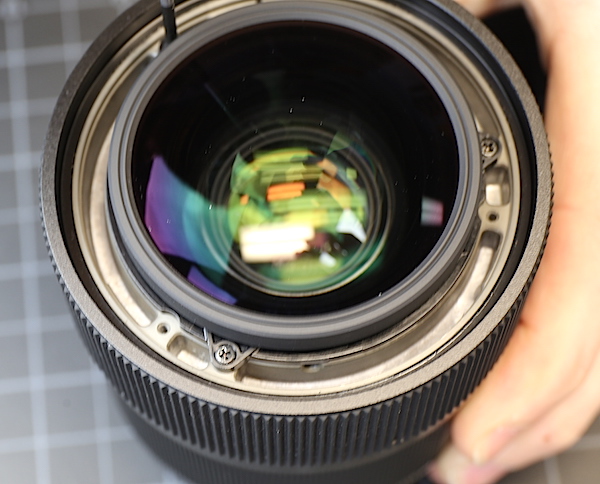
- Lensrentals.com, 2015
The front lens assembly is removed in one piece. There are front and rear screw-on caps holding the front and rear element groups in place.

- Lensrentals.com, 2015
The rings were both glued into place. The glue for the rear ring softened enough with just heat to let us remove it. Electronics gurus will use an $89 heat gun to do this. We use a $14 blow dryer. Best line ever: When I checked out with it, the clerk looked at my bald head, looked at the blow dryer, and said, “You know those cheap ones will make your hair fall out.”

- Lensrentals.com, 2015
An Aaron selfie during disassembly has become our version of a programmer’s Easter Egg.

After removing the ring, the rear element could be removed.
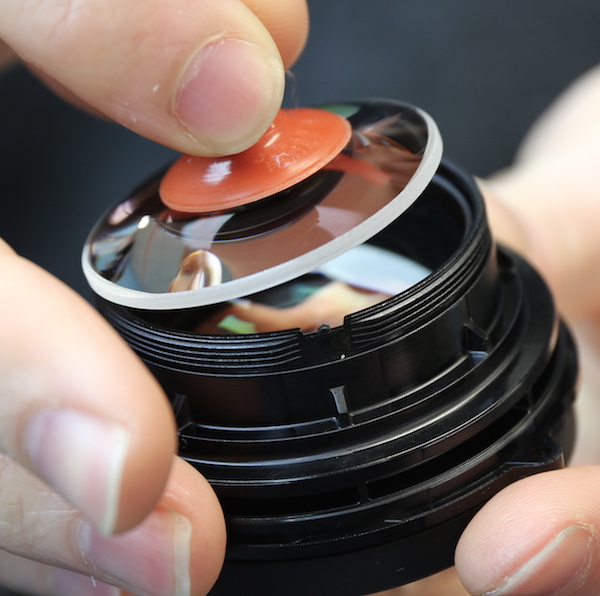
- Lensrentals.com, 2015
The front retaining ring required both heat and a little alcohol to soften the glue, but once the ring was off the front element group could be removed.
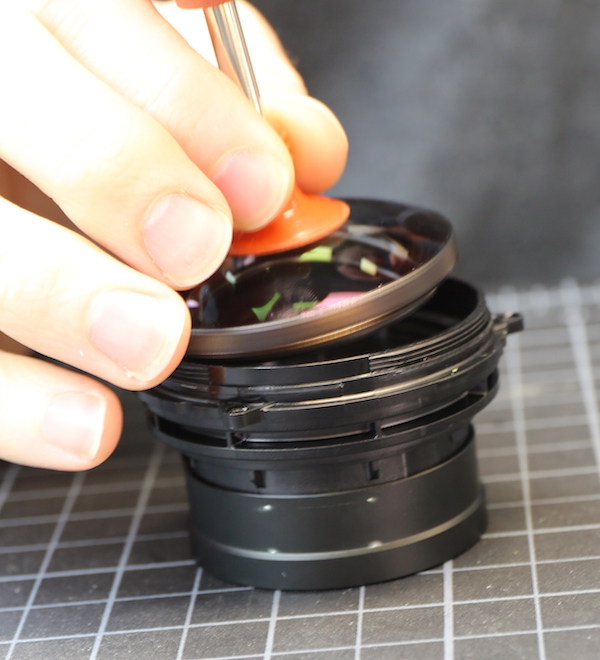
- Lensrentals.com, 2015
Looking inside the front assembly from the rear it seems the next group is held in place by a compression spring.
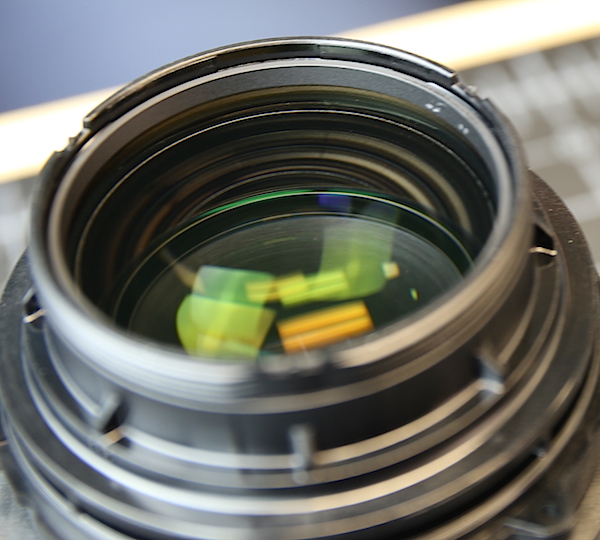
- Lensrentals.com, 2015
And the second group from the front is firmly inserted and probably glued. Our quest in opening this group was to see if there were any optical adjustments to be made here, which there are not, and to see how easy the front element should be to replace (very straightforward).

- Lensrentals.com, 2015
Setting the front lens assembly aside we can look back into the lens barrel. This is the level of the focusing ring and you can see the brass key from the ring, inserting into the fork of focusing lever that passes down to the outer barrel of the focusing group. Both of these are sturdy metal pieces.

- Lensrentals.com, 2015
Looking into the barrel, you see there are two of these focusing assemblies on opposite sides of the lens. I should mention, while we’re here, that the inner barrel is metal, not polycarbonate. All of those screws we’ve removed so far were sunk into this metal barrel.

- Lensrentals.com, 2015
The focus ring is held on by a set of three screws.
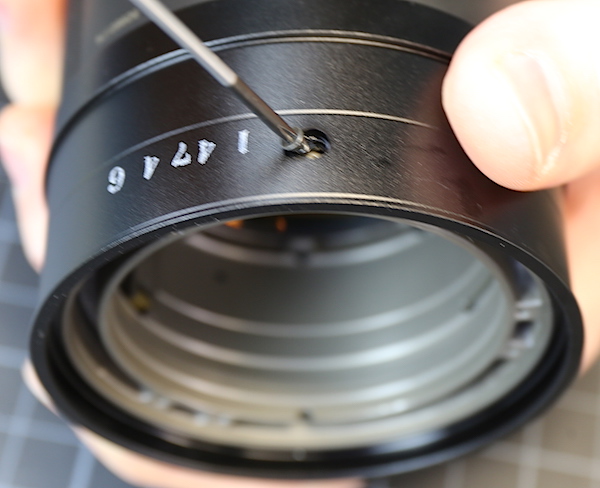
- Lensrentals.com, 2015
Once they are removed the focusing ring slides right off of the lens exposing the focusing motor beneath.

- Lensrentals.com, 2015
Now it’s time to start disassembling the back end of the lens. The rear light baffle is held in place by 3 screws.
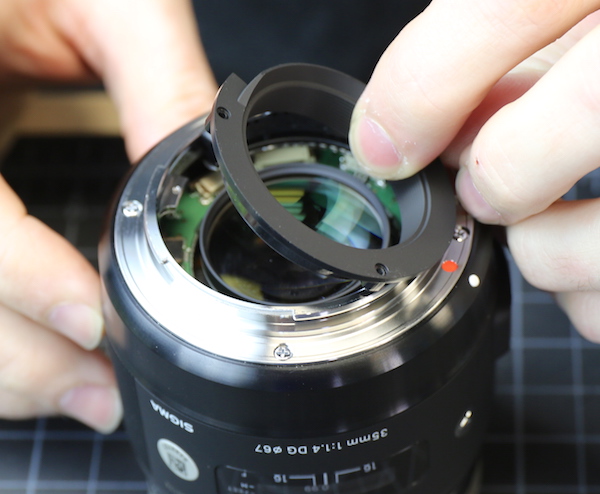
- Lensrentals.com, 2015
Then the bayonet can be removed.

- Lensrentals.com, 2015
There are some circular shims underneath the bayonet, which would be used to adjust infinity focus. With the shims out we can access the 4 screws that hold the rear barrel in place.

Lensrentals.com, 2015
And remove the rear barrel.
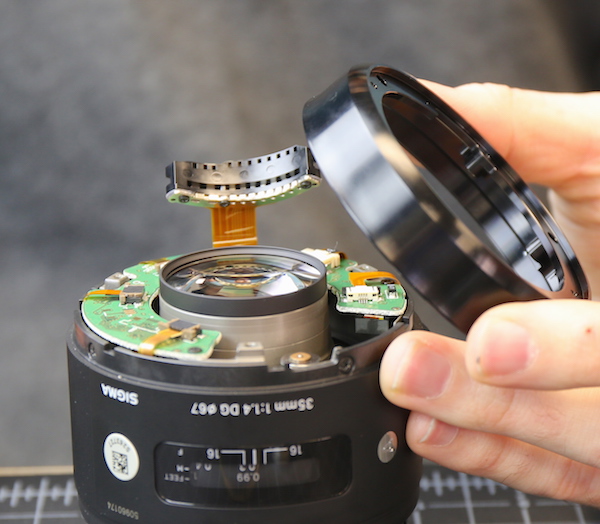
- Lensrentals.com, 2015
The Sigma PCB looks much like everyone else’s PCB. Note the aperture motor in the lower part of the picture.

- Lensrentals.com, 2015
The underside of the PCB shows a bit more electronics than most. I don’t know enough about electronics to comment other than they are there and do electronic stuff. Somebody will tell us in the comments soon enough. Knowledgeable people always explain stuff I don’t understand in the comments section. Less knowledgeable people explain stuff they don’t understand in the comments section. Sometimes it’s hard to tell which is which, though.

- Lensrentals.com, 2015
The mid barrel is attached by screws coming in from the side.

- Lensrentals.com, 2015
After taking those out, it slides right off.

- Lensrentals.com, 2015
Leaving the inner barrel nakedly exposed. Notice the small brass cover secured with two screws with the long flex coming out in the upper left. That covers the GMR detector that tells the lens focus position changes. GMR stands for Giant Magneto Resistance and is kind of a lie because they aren’t so giant but what they are is delicate. If you let almost anything touch it when you are working on the lens, it doesn’t work anymore. So spending a couple of pennies to cover it nicely like this is most appreciated. More importantly, in case you can’t tell from the picture, all of the inner barrels here are solid metal.

- Lensrentals.com, 2015
Now that we have all the flexes out where we can unthread them as they travel around, we can go back and take out the screws holding the two halves of the inner barrels together, the ones we exposed from the front.

- Lensrentals.com, 2015
And separate the front and rear halves. In Aaron’s right hand (left side of the image) is the front half which contains the AF Motor. The other side contains the focusing group. You can see the two focusing forks (I don’t know what else to call them, they have forked ends and connect the focusing ring to the focusing element) coming out of the other half of the lens. Those are position sensor brushes you see held down by two screws on the focusing barrel.

- Lensrentals.com, 2015
From above you can see the exit from slots that allow them to move the focusing group.

- Lensrentals.com, 2015
A quick demonstration, as the focusing forks turn the focusing barrel rotate and the rear element extend and retract.


Examining the collars in the rear group showed us there aren’t any optical adjustments to be made back here either. So we’d reached the point we usually do where I say, “Well, let’s put it back together. No reason to take anything else apart.” And Aaron keeps taking stuff apart while I’m talking. The screws and collars holding the rear group in place were out before I’d gotten to ‘no reason’.

- Lensrentals.com, 2015
And the rear group was out soon after. You can see the screws and nylon collars that held it in place on the mat in front. They’re pretty standard ‘what we usually see’ screws and collars.

- Lensrentals.com, 2015
The aperture assembly is on the front of the rear group assembly we just removed. This is a bit of a different look at the aperture than you usually get to see. You’re looking at the rotation plate. The aperture blades are beneath it. Each blade has a small metal post that you see poking up through the plate and another post that connects the blade to the barrel. Rotating the plate moves the aperture blades so that they open and close.

- Lensrentals.com, 2015
Looking up into the remaining barrel you can see the focusing element in its helicoid track. The closer (rearmost) helicoid was for the rear group, so both of these move during focusing. I assume one is acting as a floating element to help keep things sharp during near focus. On the other hand, the two helicoids are very similar in motion, so it could just be that the focusing groups are split into two elements for optical reasons.

- Lensrentals.com, 2015
The usual closure. Of course, the lens is reassembled, retested, and working fine. And just like every time, someone is going to comment online that we killed a lens to do a teardown.
Conclusions
For the most part, there weren’t many surprises in this teardown. We’ve seen how Sigma has remade themselves as a company making only superb optics at very reasonable prices in the last few years. This lens is constructed very well. There isn’t the amazing heavy-duty construction of the Canon 35mm f/1.4. Instead, I’d characterize the construction of the Sigma as very efficient and carefully laid out. There’s a solid metal core with other parts all connecting directly to that core. Little touches like pegs to make sure a part is inserted in the proper rotation and shields over critical parts didn’t add much expense or weight, but show care was taken in the design. There’s nothing in this teardown that looked like a weak point.
Many people are going to compare this lens to the Canon 35mm f/1.4 teardown we did and say that’s why they chose the Canon. That’s legitimate reasoning. The Canon is weather resistant, twice the price, and twice the weight, roughly. If I was going to subject my lens to harsh conditions and use, the Canon looks like the way to go if you can afford it. But if I want to carry several primes in a convenient size and at a convenient expense, the Sigma is a superb choice and I expect it will hold up very well. As always, horses for courses.
There’s another thing that needs to be discussed at some length. There are no optical adjustments in the Sigma 35mm f/1.4 Art lens that we can find. The Sony 35mm f/1.4 had a single tilt adjustment of the front group. The Canon 35mm f/1.4 had two separate adjustments. So the simple view that many people are going to take is “Roger, you should hate this lens.” There’s truth in that and I am very disappointed that we can’t optically adjust it. That’s what we do. We like taking an optically bad lens and making it better.
I am going to make a point by comparing our variation curves for all three now.

- OlafOpticalTesting, 2015
I knocked the Sigma 35mm f/1.4 for its variation when we initially reviewed it, but Sony fanboys will be correct when they get out their pitchforks and claim how I made much more of a fuss about the variation in the Sony FE 35mm f/1.4. In my defense, I’ll just point out that the Sigma has a much better MTF curve than the Sony. I’ll also add that the Sigma costs $900, the Sony $1,600 and the Canon $1,800. I’m not happy about it, I wish they had it, but I’m more forgiving that the $900 lens with higher MTF has more variation than I’d like.
Roger Cicala and Aaron Closz
Lensrentals.com
December 2015
Author: Roger Cicala
I’m Roger and I am the founder of Lensrentals.com. Hailed as one of the optic nerds here, I enjoy shooting collimated light through 30X microscope objectives in my spare time. When I do take real pictures I like using something different: a Medium format, or Pentax K1, or a Sony RX1R.
-
Mayank Khanwalker
-
Mayank Khanwalker
-
Mayank Khanwalker
-
Péter Orbán
-
johnny corcoran
-
Yannig Van de Wouwer
-
Yannig Van de Wouwer
-
Yannig Van de Wouwer
-
J4 M
-
Kenneth Mackay
-
Enrico I.
-
David Reeks
-
Andrew Sempuego
-
Adrian Vasian
-
Buc Nelson
-
Roger Cicala
-
Adam Fo
-
T Kaare Smith
-
AaronClosz
-
Jimbo Pichardo
-
chrisgull
-
Adam Palmer
-
jcov
-
Lynn Allan
-
Fred4d
-
Bob B.
